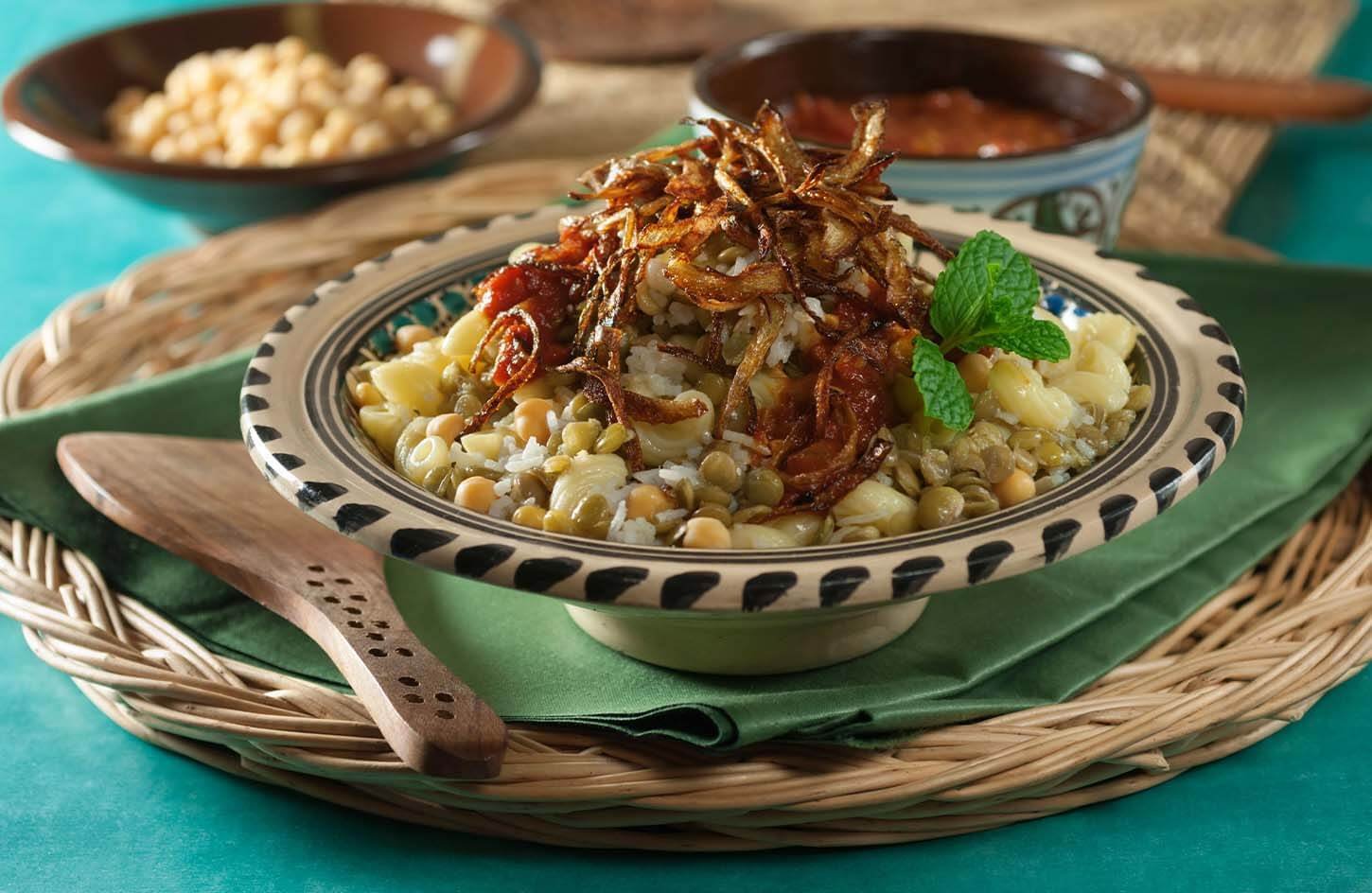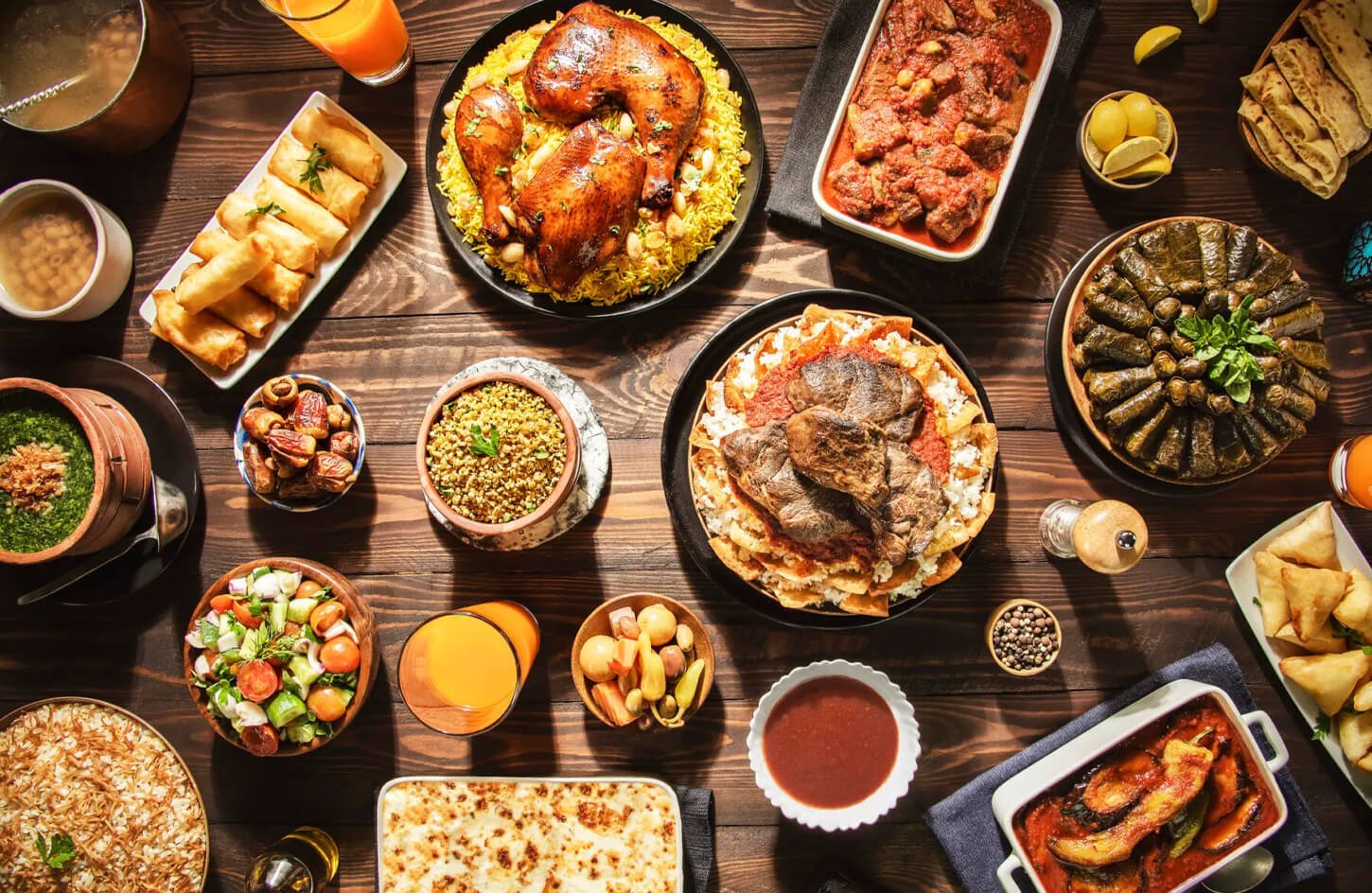Egyptian food is a mix of history and taste. It goes back to ancient times. Today, it shows the flavors of the Nile Valley and other cultures.
Try Kushari, Egypt’s favorite dish. It’s rice, lentils, and macaroni with crispy onions. Shawarma is another must, with marinated meat on a spit.
Ful wa Ta’meya is a fava bean stew with chickpea patties. Kofta and Molokhiya are great for meat lovers. Molokhiya is a green soup made with mallow leaves.
Halabesa is a warm chickpea soup for cold days. Basbousa is a sweet semolina dessert. Each dish has its own story, like Aish Baladi and Karkadeh tea.
These seven dishes are a taste of Egypt’s heart. You can try them all for under $3. They show why Egyptian food is loved worldwide.
An Introduction to Egypt’s Rich Culinary Heritage
Imagine enjoying Egyptian food that has fed people for over 4,500 years. Egyptian dishes mix ancient farming and spice trails, creating unique tastes. Every meal, from street food to family gatherings, shares stories of ancient grains and spices.
- Core Ingredients: Wheat, lentils, and chickpeas are common, with cumin, coriander, and cinnamon adding flavor.
- Historical Layers: Roman-era rice dishes, Ottoman desserts like Om Ali, and Arab salads add to the cuisine’s variety.
- Everyday Staples: Aish baladi (life bread) and Ful Medames (spiced fava beans) are favorites. Koshari, a pasta and lentil mix, shows modern touches.
Even simple meals connect to Egypt’s history. Dishes like Molokhia soup and Hawawshi (spiced meat pies) show how food adapts yet keeps traditions alive. Enjoying Ta’ameya falafel or Sahlab tea lets you taste the history of cultural exchange.
These traditions also live on today: street vendors serve Besarah (fava bean dip) like ancient Egyptians did. Egyptian dishes are more than food—they connect us to a rich culinary past.

Understanding the Cultural Significance of Egyptian Food
Egyptian food is more than just meals. It’s a story of land, time, and people. From the Nile to busy markets, each dish tells a piece of history. Let’s see how geography, history, and regions shape Egypt’s food culture.
How Geography Shaped Egyptian Cuisine
The Nile’s floods made Egypt a food paradise. For over 5,000 years, emmer wheat was a key crop. Today, dishes like koshary and ful medames still use these ingredients.
Coastal cities like Alexandria have fish markets. Upper Egypt’s dry lands love hearty stews like molokhia. This mix of resources is the base of Egypt’s top dishes.
The Historical Evolution of Egyptian Dishes
- ANCIENT ROOTS: Tomb paintings and texts show bread, beer, and lentils were daily staples 4,000 years ago.
- FOREIGN FLAVORS: Greek, Roman, and Ottoman influences added spices and cooking techniques. Yet, dishes like taameya (fava bean fritters) remain ancient in essence.
- MODERN FAVORITES: Koshary, a mix of rice, lentils, and pasta, evolved from 19th-century street food into Egypt’s signature dish.
Regional Variations in Egyptian Cooking
Flavors change from the Delta to the Red Sea:
- NORTHERN COAST: Alexandria’s markets buzz with fish grills and domiati cheese, a salty delicacy.
- UPPER EGYPT: Spicier molokhia soups and date-stuffed pastries highlight desert resilience.
- CITY VS. COUNTRYSIDE: Urban areas serve quick street eats like falafel. Rural tables focus on seasonal vegetables and bread.
Every bite of Egyptian food tells a story. It’s about survival, trade, and tradition. These layers make Egypt’s food a timeless journey.
The Essential Cuisine to Try in Egypt for First-Time Visitors
Visiting Egypt is more than seeing pyramids and history. It’s a chance to taste the cuisine to try in Egypt. The flavors of Egypt’s must-try food in Egypt share stories of tradition and diversity. You’ll find amazing dishes at street stalls and family-run eateries.
- Koshari – Egypt’s iconic dish blends lentils, rice, and crispy onions. Head to Abou Tarek in Cairo for a taste of this carb-loaded favorite.
- Ful Mudammas – Creamy mashed fava beans with garlic and olive oil. Pair with pita bread for a hearty breakfast or quick snack.
- Molokhia – A leafy green stew, often paired with chicken or beef. Its mild bitterness is a signature taste of Egyptian kitchens.
- Fiteer Meshaltet – A flaky pastry stuffed with cheese or spiced meat. Perfect for a savory or sweet breakfast option.
- Hawawshi – Spiced minced meat baked in pita bread. Look for vendors near Islamic monuments for authentic street eats.
- Macaroni bil Bechamel – Oven-baked mac ‘n’ cheese with ground beef. A homey dish that’s a comfort food staple.
Street food vendors with long lines are often your best guide—locals trust them for quality. Pair meals with kanzeh (hibiscus tea) for a refreshing twist. These dishes aren’t just meals; they’re a window into millennia of Egyptian culture. Don’t skip the must-try food in Egypt—they’re as essential as the Pyramids to your journey.
Koshari: The Beloved National Dish of Egypt
Koshari is more than food; it’s Egypt’s heart. This dish mixes simple ingredients into a flavorful mix. It’s a key part of Egypt’s food culture.
What Makes Koshari Special
- Layered ingredients: Rice, lentils, pasta, and chickpeas make up its base. Each is cooked separately for the best mix.
- Signature toppings: A tangy tomato sauce, crispy fried onions, and garlic vinegar add bold flavors.
- Affordable luxury: It started as street food for workers. Now, it’s a cheap but delicious meal for everyone.
How to Eat Koshari Like a Local
Eating Koshari is an art. Mix all layers together before eating. Add garlic vinegar for a kick or chili sauce for spice. Locals like it with pickled tomatoes or beans. Remember, let it cool a bit to avoid burning your tongue from the onions!
Where to Find the Best Koshari in Egypt
For a true taste, visit Koshary Abou Tarek in Cairo. It started as a street cart in 1950 and now costs under $2. Street vendors in Tahrir Square or Alexandria’s markets also serve great Koshari. Try it with curry spices or fried eggs for a twist.
Traditional Egyptian Meat and Seafood Delicacies
Egypt sits between land and sea, blending flavors from the Nile and the Mediterranean. Meat and seafood are grilled or cooked in clay pots. These dishes carry centuries of tradition.
- Kofta & Kebab: Juicy minced lamb or beef mixed with herbs like parsley and mint, grilled into skewers. Served with tangy salads and warm flatbread, these are top dishes in Egypt for meat lovers.
- Hamam Mahshi: Stuffed squab (young pigeon) filled with rice or bulgur, baked to perfection. A centuries-old delicacy once raised in distinctive pigeon towers across the country.
- Sayadeya: A coastal specialty from cities like Alexandria, this fish stew combines Nile tilapia or mullet with aromatic rice and spices. Perfect with lemony dips like tahini.
- Hawawshi: Spiced lamb or beef seasoned with cumin and garlic, baked in pita dough. A portable snack sold by street vendors or homemade for family meals.
Charcoal grilling adds a smoky flavor to meats. Coastal areas grill fresh catches like sardines or feseekh in spring. These dishes are more than food; they’re a trip through Egypt’s landscapes and traditions. Make sure to try these traditional dishes in Egypt when you explore the country’s culinary heart.
Sweet Treats and Desserts That Define Egyptian Cuisine
Egyptian food specialties include sweet treats that are as vibrant as the culture. Explore Egyptian culinary delights that make any meal a celebration of flavor and tradition.
Basbousa and Semolina Magic
Basbousa is a golden semolina cake with syrup. It’s a must at celebrations. The recipe uses 500g semolina and 200g sugar, baked at 350°F until crisp.
Look for Koueider, a Cairo brand since 1928, in Middle Eastern markets. Try Harissa with coconut and nuts, or namoura with rose water. Each serving has 286 kcal, making it a sweet treat.
Um Ali: A Sultan’s Legacy
Um Ali, Egypt’s iconic bread pudding, dates back to the 13th century. Shagarat el-Dur, the wife of Sultan Ezz el-Din Aybak, made it to celebrate his rise. It layers puff pastry with raisins, nuts, and milk.
Key ingredients are stale bread, milk, sugar, and cinnamon. Find it in New York’s Halawa or L.A.’s Sweet Egypt for a taste of history.
Seasonal Sweets: Festive Flavors
Seasonal Egyptian culinary delights mark life’s milestones:
- Kahk: Almond-stuffed cookies dusted with powdered sugar, baked fresh before Eid.
- Kunafa: Stringy cheese pastry soaked in syrup, a must-have during Ramadan.
- Ma’amoul: Dates-filled in shortbread-like dough, shaped in wooden molds.
- Atayef: Stuffed pancakes fried then drenched in syrup, served during Ramadan’s pre-dawn meals.
Even everyday favorites like meshabek (twisted syrup-soaked dough) or maamouniya (vermicelli-based dessert) show Egypt’s sweet creativity. These desserts make any occasion a feast.
Must-Try Egyptian Street Food Experiences
Exploring Egyptian street food is like stepping into a flavor-filled adventure. From bustling markets to humble carts, these dishes are the soul of Egyptian daily life. Here’s your guide to the must-try food in Egypt that locals can’t get enough of:
- Ful Medames: Slow-cooked fava beans mashed with olive oil, lemon, and spices. Pair it with pickles and bread for a hearty breakfast staple.
- Ta’ameya (Egyptian falafel): Made from fava beans, these crispy balls are served in a warm roll with tangy tahini and veggies—a vegan triumph tracing back to Coptic traditions.
- Hawawshi: Spiced minced meat baked inside flatbread. Look for Hawawshi el Rafaayee in Cairo for the most tender versions.
- Feteer Meshaltet: Flaky buttery pastry layered with cheese or meats. Best enjoyed fresh from street carts in the early morning.
- Shawarma: Chicken or beef marinated in garlic, cumin, and sumac, wrapped in brioche buns—a modern favorite that competes with traditional dishes.

Quench your thirst with:
- Sugarcane juice squeezed fresh at sidewalk stalls.
- Karkadeh (hibiscus tea) chilled with ice, served in colorful cups.
- Sahlab, a warm milk drink thickened with orchid powder, spiced with cinnamon and nutmeg.
Pro tips for your street food journey:
- Seek vendors with long lines—they’re often the best.
- Try small bites first to sample variety without overeating.
- Visit Khan El Khalili market or Alexandria’s streets during evening hours for peak activity.
- Ask locals for their go-to spots—they’re happy to share favorites like Farahat for grilled pigeon.
Every bite tells a story of centuries-old traditions, blending Pharaonic roots with modern flair. Let your taste buds roam Cairo’s lively streets to taste Egypt’s true flavors.
Eating Like an Egyptian: Dining Customs and Etiquette
Exploring Egyptian food is more than just trying new dishes. It’s about understanding local dining ways. Here are some tips to enjoy meals with confidence and respect.
- Meal Times Matter: Breakfast (7–10 AM) often has ful medames. Lunch (2–4 PM) is the big meal. Dinners after 8 PM are light. Try to eat at these times to live like a local.
- Table Manners: Always use your right hand when eating. Egyptians use their left for personal hygiene. When sharing, take a little first. Say something like, “This is delicious!” instead of asking if it’s good.
- Restaurant Etiquette: Tipping 10% is the norm. Look for places full of locals for a real experience. If you can’t speak the language, just point at what you want. During Ramadan, don’t eat in public during the day.
- Street food is great: choose busy stalls with fresh food. Make sure the cooking area looks clean before you order.
- Gifts and gestures: Never give pork or alcohol. Saying nice things about the food is very important.
- Communal sharing: Meals are served family-style. Leaving a bit of food on your plate means you’re happy and there’s enough.
Using the right hand and enjoying shared dishes are key. By following these customs, you’ll enjoy both the food and the culture behind it.
Conclusion: Embracing the Flavors of Egypt on Your Culinary Journey
Exploring Egyptian cuisine is more than just eating. It’s a journey through history, culture, and community. Every bite of best Egyptian cuisine tells a story. From the humble koshari to the delicate basbousa.
Egyptian street food, like taameya falafel and spiced shawarma, offers a vibrant taste of everyday life. Dishes like molokhia and ful medames reveal centuries-old traditions.
When you travel to Egypt, let your senses guide you. Wander through spice bazaars to smell cumin and coriander. Or savor aish baladi with every meal.
Don’t shy away from street carts selling hawawshi or sugarcane juice. Egyptian street food is where flavors shine brightest. Look for family-run eateries to taste authentic roz bel laban or um ali.
Bring a taste of Egypt home by experimenting with spices like sumac or rosewater. Share your discoveries online and join others celebrating this timeless cuisine. Whether you’re grilling shami kebabs or enjoying black tea with mint, Egyptian flavors will remind you of a land where food is a shared joy. Your culinary adventure starts now—what will you try first?
Read our Related Article:








